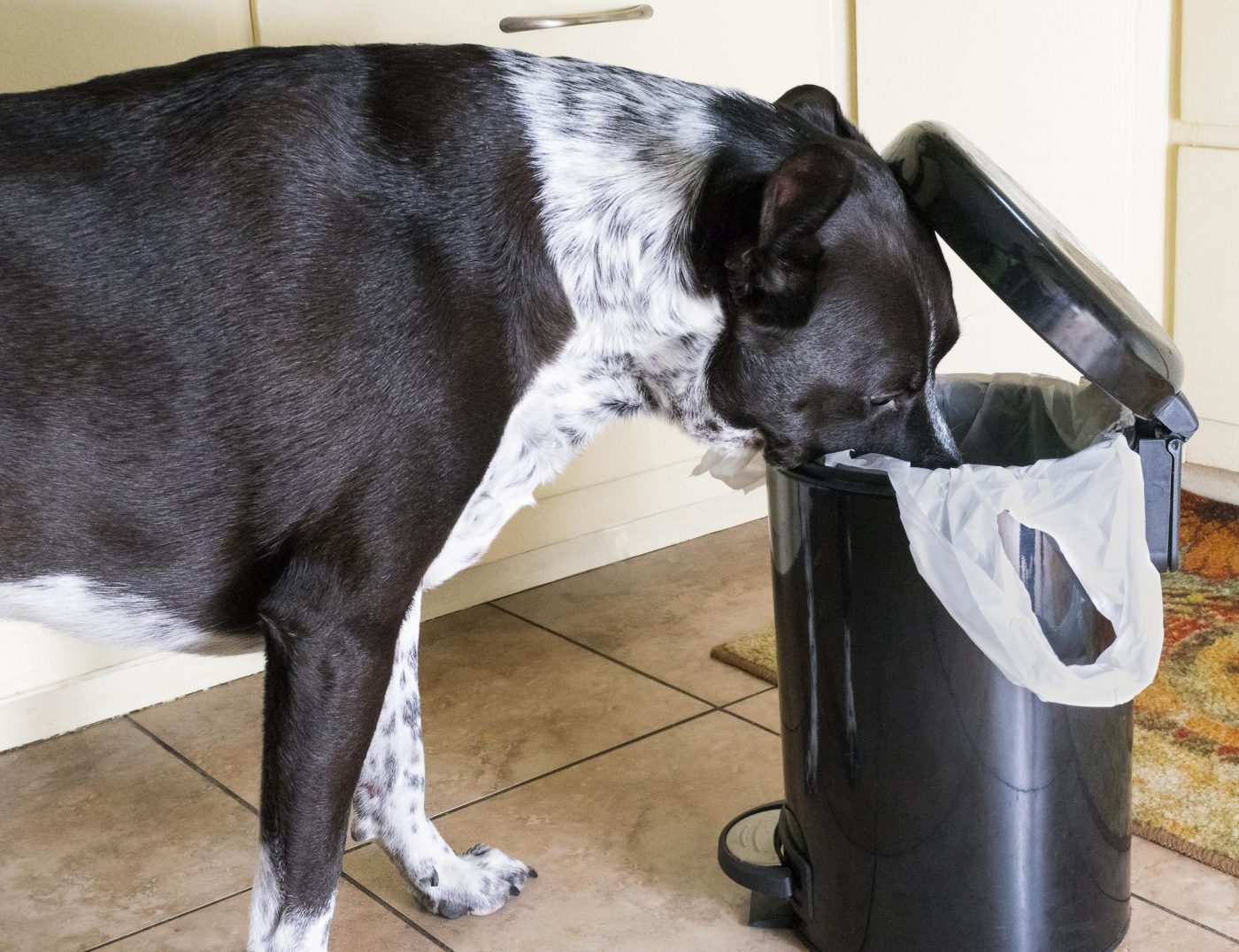- Early diagnosis and treatment are the key to a smooth recovery in mild cases of pancreatitis and can help prevent symptoms from progressing into a life-threatening condition.
- Older and overweight dogs, and dogs of certain breeds, have a higher risk for developing pancreatitis.
- Two BIG things you can do to ward off pancreatitis: prevent “dietary indiscretion” (consuming garbage and fatty table scraps) and maintain an ideal body weight.
At some point, every dog owner will witness their pup suffer a bout of vomiting or diarrhea. Very often, if they don’t last longer than a day, these episodes are nothing to worry about. But sometimes, vomiting, diarrhea, lack of appetite, and lethargy can be signs of potentially serious conditions—like pancreatitis.
The term pancreatitis refers to inflammation of the pancreas. While the pancreas may fly under the radar, it plays an important role in your dog’s health, and when it’s inflamed, it can be quite painful for your dog and in some cases lead to serious complications.
Unfortunately, this condition has been historically misunderstood, which means sometimes dog owners may not be identifying the true cause of the problem, and may miss the signs that could lead to early diagnosis and life-saving treatment. Here, we’ll cover what you need to know about canine pancreatitis including causes, symptoms, and treatment options so you have the information you need to be an advocate for your pet’s health.
What is pancreatitis in dogs?
First things first—let’s talk about the pancreas. The pancreas is a gland located near the stomach and it is a vital component of the digestive system. This gland produces specific enzymes—proteases, amylases, and lipases—that facilitate digestion and help your dog absorb fats and nutrients from food. It also plays a role in controlling blood sugar.
Pancreatitis, in simple terms, is inflammation of the pancreas. It happens when the enzymes that should be digesting food in the small intestine start targeting (and digesting) the pancreas itself instead.
This leads to an overactive immune system inflammatory response that can cause irritation, pain, and harm to pancreas as well as surrounding tissues and organs.
Canine pancreatitis can be either acute or chronic. Acute pancreatitis comes on quickly and can be quite painful for the dog, while chronic pancreatitis develops and can worsen over time. The veterinary community also recognizes two degrees of pancreatitis: mild and severe. If left undiagnosed and untreated, mild cases of pancreatitis can progress to cause more serious and sometimes life-threatening symptoms.
Though inflammation is a natural protective response by the body, chronic inflammation can lead to tissue damage which can spread to the liver and other parts of the body. When the liver is damaged, its ability to filter out toxins becomes compromised. As a result, those toxins may circulate throughout the body and cause widespread inflammation and further damage. In some cases, fatal complications can develop.
Fortunately, this inflammation is typically contained, and with prompt diagnosis and veterinary support, most dogs make a full recovery from acute cases of pancreatitis.
Signs of pancreatitis
The signs of pancreatitis are easy to miss because, in many cases, they develop slowly over time. Classic signs of pancreatitis may include the following:
- Lack of appetite
- Dehydration
- Hunched back
- Vomiting
- Distended abdomen
- Diarrhea
- General discomfort
- Fever
- Abdominal pain
Dogs with severe pancreatitis may exhibit additional signs such as:
- Irregular heartbeat
- Shock or sudden collapse
- Severe depression
- Sepsis (widespread infection)
- Difficulty breathing
It’s important to see your vet if your dog vomits more than once or twice, or is experiencing the other signs listed above. Pancreatitis is serious, and timely veterinary care will give your dog the best chance of recovering.

Causes of dog pancreatitis
Most cases of pancreatitis in pets are idiopathic—they have no known cause. Even so, veterinarians have identified a number of factors related to development of the condition:
- Excess weight
- Dietary indiscretion (i.e., consuming things that aren’t proper food, like garbage)
- Hormonal imbalance related to medical conditions like diabetes or hypothyroidism
- Toxic reaction to certain medications (ex: chemotherapy or anti-seizure drugs)
- Reflux in the pancreas or obstruction of the enzyme ducts
- Blunt trauma to the pancreas (such as surgery or a car accident)
Some research has indicated that certain breeds have a genetic predisposition to developing pancreatitis. Miniature Schnauzers, for example, have a tendency for hyperlipidaemia, or elevated levels of fat lipids in the bloodstream, and may be at a higher risk for pancreatitis. Other at-risk breeds may include miniature poodles, Cocker spaniels, Dachshunds, and some terriers. Older and overweight dogs have a higher risk for developing pancreatitis as well.
The fat factor
And then there’s fat.
Traditionally, dietary fat has been associated with pancreatitis in dogs, but fat does not actually cause pancreatitis.
One 2009 study that compared lower- and higher-fat diets found higher fat content alone was not associated with higher pancreatic response in healthy dogs. There is substantive evidence, however, that “dietary indiscretion” (i.e., dogs scarfing down food they shouldn’t eat) does play a role. As one major study found, ingesting unusual food items or table scraps, and “getting into the trash,” increased the odds of pancreatitis.
While dietary fat hasn’t been shown to cause pancreatitis, high-fat diets are associated with higher levels of oxidative stress and increased risk of inflammation in many animals.
According to veterinary nutritionists, because fat can increase the release of pancreatic enzymes that are not being released properly already, a high-fat diet can make things worse if a dog already has an underlying condition.
When it comes to fat in your dog’s diet, consider quality along with quantity. Highly processed foods like kibble are made to sit on shelves for long (long) periods of time, and during that time, the fats they contain can go rancid. Rancid fats are a health hazard, and may contribute to oxidative stress and inflammation.
Pancreatitis diagnosis and treatment options
Because pancreatitis can progress quickly and may become painful for some dogs, prompt diagnosis is essential. Bring symptoms of pancreatitis to your veterinarian’s attention as soon as possible. The sooner you have a diagnosis, the sooner your dog can begin treatment.
Some of the tools which may be used to diagnose pancreatitis include:
- Specific canine pancreatic lipase (SPEC cPL) test: This blood test checks for elevated levels of pancreatic enzymes. It detects 83% of cases and helps exclude other possible diseases.
- Ultrasound: Though this diagnostic tool may only detect about 68% of cases, it gives the veterinarian a chance to look at the other organs to check for additional complicating factors.
- Abdominal X-rays: Abdominal radiographs aren’t particularly helpful in diagnosing pancreatitis, but they may be used to rule out other causes of disease.
Based on the findings of your dog’s physical exam and laboratory testing, your veterinarian will make a diagnosis and recommend a treatment plan. Traditionally, withholding food and water for 24 hours was recommended for dogs with pancreatitis. However, according to our consulting veterinary nutritionist, and recent research, withholding food may only make the condition worse. Feeding small amounts of food during an episode can help prevent the breakdown of the gastrointestinal tract which occurs during starvation, and result in better survival rates and fewer incidences of sepsis.
Many dogs do recover from pancreatitis. With treatment and dietary modification, pancreatitis can resolve but it won’t be fully cured – the condition can always come back.

The importance of a healthy diet in preventing and treating pancreatitis
There is no denying the importance of a healthy diet in general, but nutritional management is particularly important when it comes to preventing or treating pancreatitis in dogs. Here are some of the important dietary considerations in preventing and managing pancreatitis:
Stop the scavenge: Perhaps the most important aspect of dietary management for dogs prone to pancreatitis (or any dog!) is controlling dietary indiscretion—scavenging. Some dogs will eat anything and everything, even things that don’t remotely resemble food. Avoid leaving food out on the counter at home, keep garbage cans covered, and don’t give your dog fat-laden table scraps, which can trigger an attack of pancreatitis.
The real role of fats: Keep in mind your dog requires healthy fats as part of a balanced diet—a high-quality, complete and balanced diet should provide those fats, along with protein and other nutrients in the right amounts and proportions. Ideally, your dog’s diet will provide fats in the form of fresh, lightly cooked food. But do be careful about doling out high-fat table scraps as extras (think: bacon, fat trimmings from your roast) as these ‘treats” could trigger pancreatitis, or a recurrence of the condition in the future.
For dogs who have experienced bouts of pancreatitis, a pancreas recovery diet is modestly fat restricted, but contains healthy polyunsaturated fats.
Adequate protein intake: Low-protein diets have been associated with an increased risk for pancreatitis, especially when combined with high fat intake. A complete and balanced adult maintenance diet that contains at least 24% (by dry matter) high-quality, digestible protein is the best choice for overall health, and for a healthy recovering pancreas.
Omega-3s: It’s important to note that not all fats are created equal. Omega-3 fatty acids are essential in small quantities and have anti-inflammatory properties, and healthy nutrients that can improve the quality and condition of your dog’s coat and skin, as well as support heart, brain, and joint health. And Omega-3 fatty acids like those found in fish like sardines (link) may also help reduce pancreatic inflammation. A fresh diet that contains supplemental Omega-3 fats is the best option to ensure you’re getting the right among and proportion of fats.
Plant polyphenols (aka eating vegetables): Plant polyphenols are compounds found in fresh vegetables, fruit, herbs and other foods that have been shown to have potent anti-inflammatory and antioxidant properties. Most highly processed dry food doesn’t contain whole vegetables (and if it did, the high-heat processing methods used to make it strip away some of the nutritional value). The vegetables in fresh, lightly cooked food provide these powerful nutrients which can reduce inflammation in your dog’s body, and help stave off issues like pancreatitis (as well as cancer and a host of other ailments). Consider swapping out your dog’s processed treats for small pieces of fresh vegetables like green beans or broccoli!
Healthy weight management: In addition to keeping your dog’s diet properly balanced, it’s important to monitor their calorie intake to facilitate weight loss (if needed) or to support healthy weight management. When it comes to weight, even small gains can make a big difference (read more about the importance of weight management here). That means it’s important to be accurate about portions, taking into account your dog’s age, weight, body condition, and activity level. A fresh-food plan that’s tailored to your dog’s unique needs can make this easy. Increasing your dog’s activity level can also help with weight management and overall mental and physical health.
If your dog has been diagnosed with pancreatitis, stay in touch with your veterinarian throughout your dog’s recovery. Every dog is different, so it’s difficult to predict how long it will be before your dog is back to feeling like themselves. Stick to your treatment plan and soon enough your canine companion will be healthy and happy once again.









